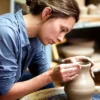Pottery enthusiasts and artists often seek to expand their skill set and knowledge by exploring different forms and techniques.
Sculpture and large-scale pottery offer unique challenges and opportunities for creativity in the pottery world.
Whether one is beginning their journey or looking to refine their abilities, selecting the right books can make all the difference.
These books can provide not only practical guidance but also inspiration from experienced artists.
When choosing books on sculpture and large-scale pottery, you should consider a few key factors.
The author’s experience and background can offer valuable insights into the techniques explored within the pages.
Additionally, look for books that offer clear illustrations or photographs to guide the learning process.
Books that include a variety of project ideas or styles may offer more diverse learning opportunities.
A thorough investigation into different books allowed us to identify those that effectively combine instruction with inspiration.
Our goal was to pinpoint resources that cater to both novices and more experienced potters, ensuring they cater to a range of artistic goals and preferences.
Best Sculpture and Large-Scale Pottery Books
We’ve curated a list of essential books for anyone passionate about sculpture and large-scale pottery.
These selections offer insight and inspiration, making them perfect additions to any ceramic enthusiast’s library.
Practical Pottery
Ideal for both beginners and experienced potters, this book offers a wealth of insightful projects and practical tips, with the added appeal of the author’s engaging style.
- Straightforward instructions that make it easy to pick up new skills
- High-quality imagery that enhances understanding
- Useful insights for both creating and selling pottery
- Some reported issues with the print quality
- Not all projects may appeal to advanced potters
- Limited focus on large-scale pottery
Practical Pottery is an exemplary guide for those interested in diving into the world of pottery.
The author’s enthusiasm and expertise shine through, especially for those who have already enjoyed his YouTube content.
Projects included are accessible and well-explained, making it a fantastic companion for anyone new to this creative field.
What we particularly appreciate about this book is the balance it strikes between instructional detail and creative inspiration.
It covers a variety of projects, from mugs to plates, which helps in broadening our pottery skills.
Additionally, the insights into selling pottery are both encouraging and practical, providing us with a deeper appreciation for the craft as a business.
Some users have raised concerns about the print quality of the book, which is something to keep in mind.
Nonetheless, the value it brings in terms of content makes it a worthwhile addition to any potter’s library.
Whether you’re just starting or looking to refine your craft, this book serves as an inspiring resource that consistently keeps us engaged.
Buying Guide
When selecting books on sculpture and large-scale pottery, it is important to consider a few key features.
We should focus on factors like content depth, author expertise, visual elements, and practical guides.
These aspects can significantly impact the learning experience.
Content Depth
Detailed information is crucial.
Books should provide comprehensive insights into techniques, history, and styles.
It’s beneficial if the book covers both beginner and advanced levels.
Author Expertise
The author’s background influences the reliability of the content.
We should look for authors with extensive experience or academic credentials in sculpture or pottery.
Visual Elements
Good visual aids enhance our comprehension.
High-quality images, diagrams, and illustrations can help us visualize techniques and outcomes.
Practical Guides
Practical, step-by-step instructions are vital.
Check if the book includes exercises or projects to practice skills learned.
| Feature | Importance |
|---|---|
| Content Depth | Thorough understanding of topics |
| Author Expertise | Credibility and expertise of the author enrich the material |
| Visual Elements | Aid in better comprehension and application of techniques |
| Practical Guides | Hands-on approaches facilitate active learning |
Thinking about these elements can guide us in finding the right book to enhance our knowledge and skills in sculpture and pottery.
Frequently Asked Questions
In exploring the world of sculpture and large-scale pottery, we address key books that provide insights for both beginners and advanced learners.
This section also guides you in distinguishing pottery types and sourcing digital versions of renowned works.
What are the top recommended books for learning sculpture and large-scale pottery?
Our top choices include detailed guides such as “Sculpture: Techniques, Forms, Concepts” by John Blackwood and “Mastering Large-Scale Ceramics” by Jim Brown.
These books offer comprehensive coverage of techniques and concepts.
Which beginner-friendly pottery books offer the best introduction to the craft?
For newcomers, “The Beginner’s Guide to Pottery and Ceramics” by Christine White and “The Potter’s Studio Handbook” by Kristin Muller provide fundamental steps and projects to get started in pottery.
What are some highly praised ceramics books that focus on advanced techniques?
“Advanced Pottery” by Linda Bloomfield and “Techniques for the Advanced Potter” by Markus Boehm are excellent resources for seasoned potters looking to expand their skills with complex techniques.
How can one distinguish between different types of pottery, such as earthenware, stoneware, and porcelain?
We can distinguish these types by their firing temperatures, durability, and appearance.
Earthenware is porous and fired at lower temperatures.
Stoneware is more durable, fired at higher temperatures, while porcelain is known for its translucent quality and high firing temperatures.
Can you recommend any comprehensive guides on pottery glazing techniques?
For glazing techniques, “The Complete Guide to High-Fire Glazes” by John Britt and “Glazes Cone 6” by Michael Bailey are insightful, covering various methods to achieve beautiful finishes and effects.
Where can I find digital versions of esteemed pottery and ceramics books?
Many of the esteemed pottery and ceramics books are available as e-books.
You can find them on platforms like Amazon Kindle, Google Books, and digital library services such as OverDrive or Hoopla.



